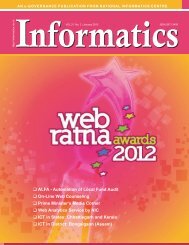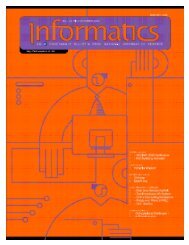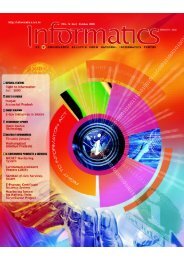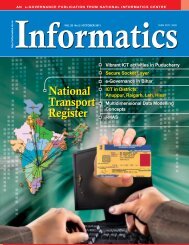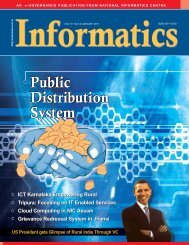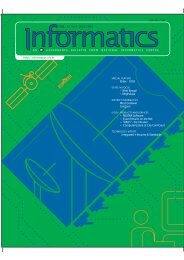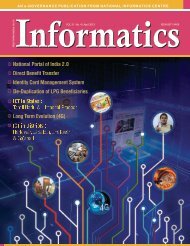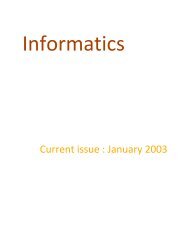Informatics-April 2008
Informatics-April 2008
Informatics-April 2008
You also want an ePaper? Increase the reach of your titles
YUMPU automatically turns print PDFs into web optimized ePapers that Google loves.
Lead Story <strong>Informatics</strong>, <strong>April</strong> <strong>2008</strong><br />
Digital Initiatives for Property Registration -<br />
e-governance towards Social Empowerment<br />
Property Registration<br />
involves recording a copy of<br />
a document and transferring<br />
the title in immovable<br />
property to the office of the<br />
Registrar. The manual<br />
process is time consuming<br />
and used to frequently lead<br />
to errors and misplacement<br />
of documents. So, in order to<br />
make the process citizen<br />
friendly, fast and free of<br />
errors, many states have<br />
chosen the ICT route and<br />
introduced online<br />
registration of property.<br />
Vinay Thakur,<br />
Technical Director,<br />
NIC HQ<br />
vinay@nic.in<br />
The State Department of Registration<br />
& Stamps is entrusted with the<br />
responsibility of registration and<br />
recording of various types of<br />
documents related to the transfer of<br />
immovable property. Each Sub-<br />
Registrar (SR) registers around 30-40<br />
documents every day. At present,<br />
there are around 4000 SR offices in<br />
the country that indulge in activities<br />
such as sale of stamps, registration of<br />
documents, search of documents and<br />
other important activities. Though<br />
detailed information about functions<br />
and working procedures of the<br />
systems are as per Registration Act,<br />
1908, the State Governments are<br />
authorised to make certain rules and<br />
procedures as per State Registration<br />
Manuals. The State Government fixes<br />
stamp duty and circle rates. The<br />
manual process involves maintenance<br />
of paper copy of all the registered<br />
documents in the large record rooms,<br />
which act as the repository of all<br />
documents. Further, the manual<br />
procedure of maintaining and<br />
registering property documents costs<br />
heavily to the Registration<br />
A typical Registration Record Room<br />
Department due to misclassification<br />
of documents, mis-representation of<br />
facts and other such losses. Searching<br />
of Reports, Records and issuance of<br />
C e r t i f i c a t e c o p i e s a n d N o n<br />
Encumbrance Certificates take long<br />
time and turns out to be a cumbersome<br />
task since it is done manually.<br />
Computerisation – the need of the<br />
hour<br />
Lately a few states have taken<br />
initiatives in computerising the needbased<br />
functions. However, in order to<br />
offer exemplary citizen services, all<br />
macro and micro level issues need to<br />
be addressed. This is possible through<br />
optimal use of ICT. The immediate<br />
requirements of Registration<br />
Department are:<br />
(a) On line availability of deed<br />
formats.<br />
(b) Guidance values should be made<br />
a v a i l a b l e o n w e b ; a n d<br />
p e r i o d i c a l l y u p d a t e d f o r<br />
calculation of stamp duty.<br />
(c) Abolition of use of stamp<br />
papers; stamp duty<br />
payments through banks<br />
should be the part of the<br />
system.<br />
(d) The entire process of<br />
r e g i s t r a t i o n t o b e<br />
completed in a short time<br />
(30 minutes), including<br />
scanning of deeds and<br />
generation of reports.<br />
4



